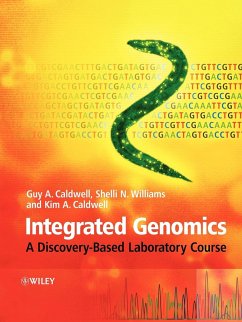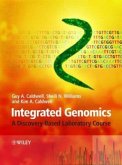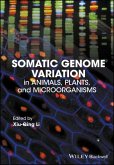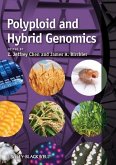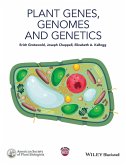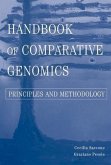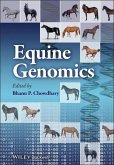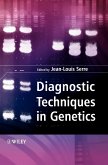Guy A. Caldwell, Shelli N. Williams, Kim A. Caldwell
Integrated Genomics
A Discovery-Based Laboratory Course
Guy A. Caldwell, Shelli N. Williams, Kim A. Caldwell
Integrated Genomics
A Discovery-Based Laboratory Course
- Broschiertes Buch
- Merkliste
- Auf die Merkliste
- Bewerten Bewerten
- Teilen
- Produkt teilen
- Produkterinnerung
- Produkterinnerung
Diese spannende, gut nachvollziehbare Einführung in das moderne Gebiet der Genomforschung ist eine gelungene Mischung ais methogologischen Informationen zur Molekularbiologie und Arbeitsanleitungen zur sinnvollen Benutzung online verfügbarer Datenbanken.
Andere Kunden interessierten sich auch für
![Integrated Genomics Integrated Genomics]() Guy A. CaldwellIntegrated Genomics262,99 €
Guy A. CaldwellIntegrated Genomics262,99 €![Somatic Genome Variation Somatic Genome Variation]() Somatic Genome Variation242,99 €
Somatic Genome Variation242,99 €![Polyploid and Hybrid Genomics Polyploid and Hybrid Genomics]() Polyploid and Hybrid Genomics254,99 €
Polyploid and Hybrid Genomics254,99 €![Plant Genes, Genomes and Genetics Plant Genes, Genomes and Genetics]() Erich GrotewoldPlant Genes, Genomes and Genetics90,99 €
Erich GrotewoldPlant Genes, Genomes and Genetics90,99 €![Handbook of Comparative Genomics Handbook of Comparative Genomics]() Cecilia SacconeHandbook of Comparative Genomics232,99 €
Cecilia SacconeHandbook of Comparative Genomics232,99 €![Equine Genomics Equine Genomics]() Bhanu P. ChowdharyEquine Genomics210,99 €
Bhanu P. ChowdharyEquine Genomics210,99 €![Diagnostic Techniques in Genetics Diagnostic Techniques in Genetics]() Jean-Louis Serre (ed.)Diagnostic Techniques in Genetics241,99 €
Jean-Louis Serre (ed.)Diagnostic Techniques in Genetics241,99 €-
-
-
Diese spannende, gut nachvollziehbare Einführung in das moderne Gebiet der Genomforschung ist eine gelungene Mischung ais methogologischen Informationen zur Molekularbiologie und Arbeitsanleitungen zur sinnvollen Benutzung online verfügbarer Datenbanken.
Hinweis: Dieser Artikel kann nur an eine deutsche Lieferadresse ausgeliefert werden.
Hinweis: Dieser Artikel kann nur an eine deutsche Lieferadresse ausgeliefert werden.
Produktdetails
- Produktdetails
- Verlag: Wiley & Sons
- 1. Auflage
- Seitenzahl: 248
- Erscheinungstermin: 1. September 2006
- Englisch
- Abmessung: 280mm x 210mm x 14mm
- Gewicht: 719g
- ISBN-13: 9780470095027
- ISBN-10: 0470095024
- Artikelnr.: 21539784
- Herstellerkennzeichnung
- Libri GmbH
- Europaallee 1
- 36244 Bad Hersfeld
- 06621 890
- Verlag: Wiley & Sons
- 1. Auflage
- Seitenzahl: 248
- Erscheinungstermin: 1. September 2006
- Englisch
- Abmessung: 280mm x 210mm x 14mm
- Gewicht: 719g
- ISBN-13: 9780470095027
- ISBN-10: 0470095024
- Artikelnr.: 21539784
- Herstellerkennzeichnung
- Libri GmbH
- Europaallee 1
- 36244 Bad Hersfeld
- 06621 890
Guy A. Caldwell, Ph.D., is an Assistant Professor in the Department of Biological Sciences at The University of Alabama in Tuscaloosa, where since 1999, he has held an undergraduate professorial appointment from the Howard Hughes Medical Institute. In 2001, Dr. Caldwell was named a Basil O'Connor Scholar of The March of Dimes Birth Defects Foundation for his research into the molecular basis of childhood birth defects of the brain. Dr. Caldwell is a recipient of grants from The March of Dimes, National Institutes of Health, the Dystonia Medical Research Foundation, American Parkinson's Disease Association, Parkinson's Disease Foundation, and the National Parkinson Foundation. In January 2003, The Caldwell lab was selected as one of only 11 worldwide to represent the research goals of The Michael J. Fox Foundation for Parkinson's Research in their Protein Degradation Grant Initiative. For his combined teaching and research efforts, Dr. Caldwell was also chosen as the recipient of a 2003 CAREER award from the National Science Foundation, the most prestigious honor for young faculty bestowed by that organization. He is the author of 2 editions of a widely adopted textbook in biotechnology sold worldwide in 3 languages by Harcourt. He currently teaches courses in Molecular Genomics, Neuronal Signaling Mechanisms, General Biology, and an acclaimed seminar on the societal impact of the Human Genome Project. Shelli N. Williams, B.Sc., is a doctoral candidate in the Department of Biological Sciences at The University of Alabama in Tuscaloosa, where she has attended the university as an undergraduate and graduate student since 1997. Following her early graduation magna cum laude from the university, Ms. Williams began her graduate work in the laboratory of Dr. Guy A. Caldwell. She has experience teaching introductory biology courses to both major and non-major students and has served as teaching assistant for a senior level discovery-based genomics course funded by the Howard Hughes Medical Institute. Kim A. Caldwell, Ph.D. is an Adjunct Assistant Professor in the Department of Biological Sciences at The University of Alabama Dr. Caldwell serves as an administrative liaison for a 1.8 million dollar grant from the Howard Hughes Medical Institute to the Department of Biological Sciences at Alabama and is Director of the HHMI Rural Science Scholars program at Alabama. She has designed and taught courses in General Biology, a seminar on the societal impact of the Human Genome Project, and course is a entitled "The Language of Research" which she teaches jointly for Howard Hughes Research Interns at both Stillman College and The University of Alabama.
Preface.
Author biographies.
Acknowledgments.
List of figures.
1 Introduction to basic laboratory genetics.
1.1 Transferring and handling C. elegans.
1.2 Introduction to laboratory genetics.
2 Gene expression analysis using transgenic animals.
2.1 Transgenic gene expression analysis in C. elegans: lacZ staining.
2.2 Transgenic gene expression analysis in C. elegans: GFP analysis.
3 Creation and testing of transgenic yeast for use in protein-protein
interaction screening.
3.1 Small-scale transformation of S. cerevisiae.
3.2 Transformation of S. cerevisiae to test for non-specific interaction.
3.3 Assaying for protein-protein interaction by reporter gene expression.
4 Yeast two-hybrid screening.
4.1 Protein-protein interaction screening of a C. elegans cDNA library.
4.2 Assaying for protein-protein interaction by reporter gene expression.
5 Isolation and identification of interacting proteins.
5.1 Preparation of electrocompetent E. coli.
5.2 Isolation of DNA from yeast and electroporation of E. coli.
5.3 Small-scale isolation of plasmid DNA from E. coli: the mini-prep.
5.4 Sequencing of two-hybrid library plasmid DNA vectors.
6 Using bioinformatics in modern science.
6.1 DNA sequence chromatogram.
6.2 BLASTing your sequence.
6.3 Evaluating sequence results and choosing an RNAi target.
6.4 Bioinformatics practice questions.
7 Generation of an RNAi vector.
7.1 Small-scale isolation of genomic DNA from C. elegans.
7.2 PCR amplification of target gene sequence from C. elegans genomic DNA.
7.3 Preparations for cloning to generate RNAi vector.
7.3.1 Agarose gel electrophoresis.
7.3.2 Removal of dNTPs from PCR reaction.
7.3.3 Restriction enzyme digestion of PCR product and C. elegans RNAi
vector.
7.4 Gel purification of DNA and ligation of vector and PCR-amplified DNA.
7.4.1 Preparative agarose gel electrophoresis.
7.4.2 Gel purification of DNA from agarose gel.
7.4.3 Ligation of vector and PCR-amplified DNA.
7.5 Transformation of ligation reactions.
7.6 PCR screening of transformation colonies.
7.7 Small-scale isolation of plasmid DNA from E. coli: the mini-prep.
7.8 Verifying successful ligation by restriction digestion.
8 RNA-mediated interference by bacterial feeding.
8.1 Preparation of RNAi-feeding bacteria for transformation.
8.2 Media preparation for RNAi feeding.
8.3 Transformation of RNAi-feeding strain HT115(DE3).
8.4 RNA interference by bacterial feeding of C. elegans.
8.5 Analyzing effects of dsRNAi.
8.5.1 Assaying for sterility (Ste) or embryonic lethality (Emb).
8.5.2 Assaying for growth effect.
8.5.3 Assaying for morphological effects.
8.5.4 Assaying for general neuromuscular effects.
8.5.5 Assaying for specific neuronal effects.
8.5.6 Assaying for dauer formation.
Appendix I Recombinational cloning.
AI.1 Isolation of genomic DNA from C. elegans.
AI.2 PCR amplification of target gene sequence from C. elegans genomic DNA.
AI.3 Agarose gel electrophoresis and clean-up of PCR reaction.
AI.4 Entry vector cloning.
AI.5 Small-scale isolation of plasmid DNA from E. coli: the mini-prep.
AI.6 Destination vector cloning.
AI.7 Small-scale isolation of plasmid DNA from E. coli: the mini-prep.
Appendix II Recipes and media preparation.
Solution recipes.
Media preparation.
Appendix III Sterile techniques and worm protocols.
Sterile techniques.
Worm protocols.
Appendix IV Mutant C. elegans phenotypes.
Appendix V Vector maps.
Subject index.
Author biographies.
Acknowledgments.
List of figures.
1 Introduction to basic laboratory genetics.
1.1 Transferring and handling C. elegans.
1.2 Introduction to laboratory genetics.
2 Gene expression analysis using transgenic animals.
2.1 Transgenic gene expression analysis in C. elegans: lacZ staining.
2.2 Transgenic gene expression analysis in C. elegans: GFP analysis.
3 Creation and testing of transgenic yeast for use in protein-protein
interaction screening.
3.1 Small-scale transformation of S. cerevisiae.
3.2 Transformation of S. cerevisiae to test for non-specific interaction.
3.3 Assaying for protein-protein interaction by reporter gene expression.
4 Yeast two-hybrid screening.
4.1 Protein-protein interaction screening of a C. elegans cDNA library.
4.2 Assaying for protein-protein interaction by reporter gene expression.
5 Isolation and identification of interacting proteins.
5.1 Preparation of electrocompetent E. coli.
5.2 Isolation of DNA from yeast and electroporation of E. coli.
5.3 Small-scale isolation of plasmid DNA from E. coli: the mini-prep.
5.4 Sequencing of two-hybrid library plasmid DNA vectors.
6 Using bioinformatics in modern science.
6.1 DNA sequence chromatogram.
6.2 BLASTing your sequence.
6.3 Evaluating sequence results and choosing an RNAi target.
6.4 Bioinformatics practice questions.
7 Generation of an RNAi vector.
7.1 Small-scale isolation of genomic DNA from C. elegans.
7.2 PCR amplification of target gene sequence from C. elegans genomic DNA.
7.3 Preparations for cloning to generate RNAi vector.
7.3.1 Agarose gel electrophoresis.
7.3.2 Removal of dNTPs from PCR reaction.
7.3.3 Restriction enzyme digestion of PCR product and C. elegans RNAi
vector.
7.4 Gel purification of DNA and ligation of vector and PCR-amplified DNA.
7.4.1 Preparative agarose gel electrophoresis.
7.4.2 Gel purification of DNA from agarose gel.
7.4.3 Ligation of vector and PCR-amplified DNA.
7.5 Transformation of ligation reactions.
7.6 PCR screening of transformation colonies.
7.7 Small-scale isolation of plasmid DNA from E. coli: the mini-prep.
7.8 Verifying successful ligation by restriction digestion.
8 RNA-mediated interference by bacterial feeding.
8.1 Preparation of RNAi-feeding bacteria for transformation.
8.2 Media preparation for RNAi feeding.
8.3 Transformation of RNAi-feeding strain HT115(DE3).
8.4 RNA interference by bacterial feeding of C. elegans.
8.5 Analyzing effects of dsRNAi.
8.5.1 Assaying for sterility (Ste) or embryonic lethality (Emb).
8.5.2 Assaying for growth effect.
8.5.3 Assaying for morphological effects.
8.5.4 Assaying for general neuromuscular effects.
8.5.5 Assaying for specific neuronal effects.
8.5.6 Assaying for dauer formation.
Appendix I Recombinational cloning.
AI.1 Isolation of genomic DNA from C. elegans.
AI.2 PCR amplification of target gene sequence from C. elegans genomic DNA.
AI.3 Agarose gel electrophoresis and clean-up of PCR reaction.
AI.4 Entry vector cloning.
AI.5 Small-scale isolation of plasmid DNA from E. coli: the mini-prep.
AI.6 Destination vector cloning.
AI.7 Small-scale isolation of plasmid DNA from E. coli: the mini-prep.
Appendix II Recipes and media preparation.
Solution recipes.
Media preparation.
Appendix III Sterile techniques and worm protocols.
Sterile techniques.
Worm protocols.
Appendix IV Mutant C. elegans phenotypes.
Appendix V Vector maps.
Subject index.
Preface.
Author biographies.
Acknowledgments.
List of figures.
1 Introduction to basic laboratory genetics.
1.1 Transferring and handling C. elegans.
1.2 Introduction to laboratory genetics.
2 Gene expression analysis using transgenic animals.
2.1 Transgenic gene expression analysis in C. elegans: lacZ staining.
2.2 Transgenic gene expression analysis in C. elegans: GFP analysis.
3 Creation and testing of transgenic yeast for use in protein-protein
interaction screening.
3.1 Small-scale transformation of S. cerevisiae.
3.2 Transformation of S. cerevisiae to test for non-specific interaction.
3.3 Assaying for protein-protein interaction by reporter gene expression.
4 Yeast two-hybrid screening.
4.1 Protein-protein interaction screening of a C. elegans cDNA library.
4.2 Assaying for protein-protein interaction by reporter gene expression.
5 Isolation and identification of interacting proteins.
5.1 Preparation of electrocompetent E. coli.
5.2 Isolation of DNA from yeast and electroporation of E. coli.
5.3 Small-scale isolation of plasmid DNA from E. coli: the mini-prep.
5.4 Sequencing of two-hybrid library plasmid DNA vectors.
6 Using bioinformatics in modern science.
6.1 DNA sequence chromatogram.
6.2 BLASTing your sequence.
6.3 Evaluating sequence results and choosing an RNAi target.
6.4 Bioinformatics practice questions.
7 Generation of an RNAi vector.
7.1 Small-scale isolation of genomic DNA from C. elegans.
7.2 PCR amplification of target gene sequence from C. elegans genomic DNA.
7.3 Preparations for cloning to generate RNAi vector.
7.3.1 Agarose gel electrophoresis.
7.3.2 Removal of dNTPs from PCR reaction.
7.3.3 Restriction enzyme digestion of PCR product and C. elegans RNAi
vector.
7.4 Gel purification of DNA and ligation of vector and PCR-amplified DNA.
7.4.1 Preparative agarose gel electrophoresis.
7.4.2 Gel purification of DNA from agarose gel.
7.4.3 Ligation of vector and PCR-amplified DNA.
7.5 Transformation of ligation reactions.
7.6 PCR screening of transformation colonies.
7.7 Small-scale isolation of plasmid DNA from E. coli: the mini-prep.
7.8 Verifying successful ligation by restriction digestion.
8 RNA-mediated interference by bacterial feeding.
8.1 Preparation of RNAi-feeding bacteria for transformation.
8.2 Media preparation for RNAi feeding.
8.3 Transformation of RNAi-feeding strain HT115(DE3).
8.4 RNA interference by bacterial feeding of C. elegans.
8.5 Analyzing effects of dsRNAi.
8.5.1 Assaying for sterility (Ste) or embryonic lethality (Emb).
8.5.2 Assaying for growth effect.
8.5.3 Assaying for morphological effects.
8.5.4 Assaying for general neuromuscular effects.
8.5.5 Assaying for specific neuronal effects.
8.5.6 Assaying for dauer formation.
Appendix I Recombinational cloning.
AI.1 Isolation of genomic DNA from C. elegans.
AI.2 PCR amplification of target gene sequence from C. elegans genomic DNA.
AI.3 Agarose gel electrophoresis and clean-up of PCR reaction.
AI.4 Entry vector cloning.
AI.5 Small-scale isolation of plasmid DNA from E. coli: the mini-prep.
AI.6 Destination vector cloning.
AI.7 Small-scale isolation of plasmid DNA from E. coli: the mini-prep.
Appendix II Recipes and media preparation.
Solution recipes.
Media preparation.
Appendix III Sterile techniques and worm protocols.
Sterile techniques.
Worm protocols.
Appendix IV Mutant C. elegans phenotypes.
Appendix V Vector maps.
Subject index.
Author biographies.
Acknowledgments.
List of figures.
1 Introduction to basic laboratory genetics.
1.1 Transferring and handling C. elegans.
1.2 Introduction to laboratory genetics.
2 Gene expression analysis using transgenic animals.
2.1 Transgenic gene expression analysis in C. elegans: lacZ staining.
2.2 Transgenic gene expression analysis in C. elegans: GFP analysis.
3 Creation and testing of transgenic yeast for use in protein-protein
interaction screening.
3.1 Small-scale transformation of S. cerevisiae.
3.2 Transformation of S. cerevisiae to test for non-specific interaction.
3.3 Assaying for protein-protein interaction by reporter gene expression.
4 Yeast two-hybrid screening.
4.1 Protein-protein interaction screening of a C. elegans cDNA library.
4.2 Assaying for protein-protein interaction by reporter gene expression.
5 Isolation and identification of interacting proteins.
5.1 Preparation of electrocompetent E. coli.
5.2 Isolation of DNA from yeast and electroporation of E. coli.
5.3 Small-scale isolation of plasmid DNA from E. coli: the mini-prep.
5.4 Sequencing of two-hybrid library plasmid DNA vectors.
6 Using bioinformatics in modern science.
6.1 DNA sequence chromatogram.
6.2 BLASTing your sequence.
6.3 Evaluating sequence results and choosing an RNAi target.
6.4 Bioinformatics practice questions.
7 Generation of an RNAi vector.
7.1 Small-scale isolation of genomic DNA from C. elegans.
7.2 PCR amplification of target gene sequence from C. elegans genomic DNA.
7.3 Preparations for cloning to generate RNAi vector.
7.3.1 Agarose gel electrophoresis.
7.3.2 Removal of dNTPs from PCR reaction.
7.3.3 Restriction enzyme digestion of PCR product and C. elegans RNAi
vector.
7.4 Gel purification of DNA and ligation of vector and PCR-amplified DNA.
7.4.1 Preparative agarose gel electrophoresis.
7.4.2 Gel purification of DNA from agarose gel.
7.4.3 Ligation of vector and PCR-amplified DNA.
7.5 Transformation of ligation reactions.
7.6 PCR screening of transformation colonies.
7.7 Small-scale isolation of plasmid DNA from E. coli: the mini-prep.
7.8 Verifying successful ligation by restriction digestion.
8 RNA-mediated interference by bacterial feeding.
8.1 Preparation of RNAi-feeding bacteria for transformation.
8.2 Media preparation for RNAi feeding.
8.3 Transformation of RNAi-feeding strain HT115(DE3).
8.4 RNA interference by bacterial feeding of C. elegans.
8.5 Analyzing effects of dsRNAi.
8.5.1 Assaying for sterility (Ste) or embryonic lethality (Emb).
8.5.2 Assaying for growth effect.
8.5.3 Assaying for morphological effects.
8.5.4 Assaying for general neuromuscular effects.
8.5.5 Assaying for specific neuronal effects.
8.5.6 Assaying for dauer formation.
Appendix I Recombinational cloning.
AI.1 Isolation of genomic DNA from C. elegans.
AI.2 PCR amplification of target gene sequence from C. elegans genomic DNA.
AI.3 Agarose gel electrophoresis and clean-up of PCR reaction.
AI.4 Entry vector cloning.
AI.5 Small-scale isolation of plasmid DNA from E. coli: the mini-prep.
AI.6 Destination vector cloning.
AI.7 Small-scale isolation of plasmid DNA from E. coli: the mini-prep.
Appendix II Recipes and media preparation.
Solution recipes.
Media preparation.
Appendix III Sterile techniques and worm protocols.
Sterile techniques.
Worm protocols.
Appendix IV Mutant C. elegans phenotypes.
Appendix V Vector maps.
Subject index.

